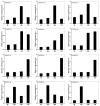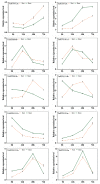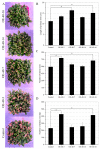A Surprising Diversity of Xyloglucan Endotransglucosylase/Hydrolase in Wheat: New in Sight to the Roles in Drought Tolerance
- PMID: 37373033
- PMCID: PMC10297901
- DOI: 10.3390/ijms24129886
A Surprising Diversity of Xyloglucan Endotransglucosylase/Hydrolase in Wheat: New in Sight to the Roles in Drought Tolerance
Abstract
Drought has become a major limiting factor for wheat productivity, and its negative impact on crop growth is anticipated to increase with climate deterioration in arid areas. Xyloglucan endoglycosylases/hydrolases (XTHs) are involved in constructing and remodeling cell wall structures and play an essential role in regulating cell wall extensibility and stress responses. However, there are no systematic studies on the wheat XTH gene family. In this study, 71 wheat XTH genes (TaXTHs) were characterized and classified into three subgroups through phylogenetic analysis. Genomic replication promoted the expansion of TaXTHs. We found a catalytically active motif and a potential N-linked glycosylation domain in all TaXTHs. Further expression analysis revealed that many TaXTHs in the roots and shoots were significantly associated with drought stress. The wheat TaXTH12.5a gene was transferred into Arabidopsis to verify a possible role of TaXTHs in stress response. The transgenic plants possessed higher seed germination rates and longer roots and exhibited improved tolerance to drought. In conclusion, bioinformatics and gene expression pattern analysis indicated that the TaXTH genes played a role in regulating drought response in wheat. The expression of TaXTH12.5a enhanced drought tolerance in Arabidopsis and supported the XTH genes' role in regulating drought stress response in plants.
Keywords: XTH gene family; drought; root plasticity; transgenic; wheat.
Conflict of interest statement
We declare that we have no financial and personal relationships with other people or organizations that can inappropriately influence our work, there is no professional or other personal interest of any nature or kind in any product, service, and/or company that could be construed as influencing the position presented in, or the review of, the manuscript entitled.
Figures








References
-
- Kao S.C., Ganguly A.R. Intensity, duration, and frequency of precipitation extremes under 21st-century warming scenarios. J. Geophys. Res. Atmos. 2011;116:D16. doi: 10.1029/2010JD015529. - DOI
-
- Balla K., Rakszegi M., Li Z., Bekes F., Bencze S., Veisz O. Quality of winter wheat in relation to heat and drought shock after anthesis. Czech J. Food Sci. 2011;29:117–128. doi: 10.17221/227/2010-CJFS. - DOI
-
- Farooq M., Wahid A., Kobayashi N., Fujita D., Basra S.M.A. Plant drought stress: Effects, mechanisms and management. Agron. Sustain. Dev. 2009;29:185–212. doi: 10.1051/agro:2008021. - DOI
-
- Salehi-Lisar S.Y., Bakhshayeshan-Agdam H. Drought Stress in Plants: Causes, Consequences, and Tolerance. Drought Stress Toler. Plants. 2016;1:1–16. doi: 10.1007/978-3-319-28899-4_1. - DOI
MeSH terms
Substances
Grants and funding
LinkOut - more resources
Full Text Sources
Other Literature Sources

